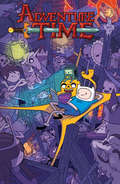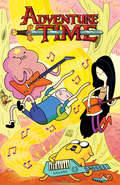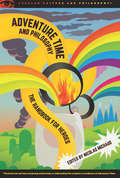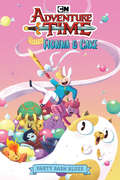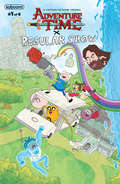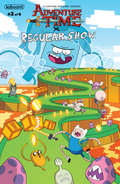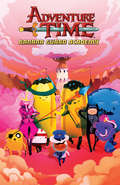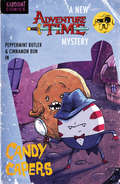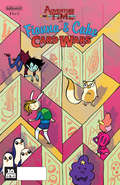- Table View
- List View
Adventure Time Volume 8 (Planet of the Apes #35 - 39)
by Pendleton Ward<p>It's the end of one era and the beginning of another in this collection that includes the very the last issue by Ryan North and artists Shelli & Braden as they take the AT gang on one last one-shot adventure, and introduces indie all-stars Christopher Hastings and Zachary Sterling as they start Finn and Jake on an adventure that is as tasty as it is dangerous! Collects issues 35-39. <p>This is a fixed-format ebook, which preserves the design and layout of the original print book.</p>
Adventure Time Volume 9 (Planet of the Apes #40 - 44)
by Pendleton WardFinn and Jake find themselves in the middle of a secret war when they inaverdantly take out Peppermint Butler's secret agent Candy Bar! There is something going on with the King of Ooo and the weird bears that he's hanging out with and it's up to Finn and Jake to get to the bottom of the King's dastardly plot! ...if only they weren't being accused of treason in the process. Collects issues 40-44. <p>This is a fixed-format ebook, which preserves the design and layout of the original print book.</p>
Adventure Time and Philosophy
by Nicolas MichaudAdventure Time and Philosophy is a monster-beating, wild ride of philosophical mayhem. The authors have come together to understand and explore one of the deepest and most thoughtful television shows ever to assault human brain waves. Where Adventure Time shows us what the world could be like, this book screws open our cranial lids, mucks about in the mess that is our heads, and attempts to come to some answers about the nature of reality. Adventure Time challenges everything we know about life, meaning, heroism, and even burritos. And it's time to give the show some serious thought. Adventure Time and Philosophy is a chance to put down your broadsword, put your exhausted monster-slaying feet up, and try to figure out why you spend your time rescuing people in distress and fighting for justice. What is justice anyway? If you don't happen to have your pocket edition of the Enchiridion on hand, and Billy the Hero *wicked guitar solo* hasn't been returning your calls, pick up Adventure Time and Philosophy and learn what it means to be a real hero! The authors of the chapters will prove that Adventure Time is much more than a cartoon, it's a way of life. . . . It's also the future!--a post-apocalyptic future 10,000 years after the Great Mushroom War, actually. Who better to have as companions than Finn and Jake when taking on Plato, Nietzsche, and Baudrillard or encountering the Slime Princess, the Ice King, and Marceline the Vampire Queen. In a review of the show in Entertainment Weekly, Darren Franich characterized Adventure Time as a "hybrid sci-fi/fantasy/horror/musical/fairy tale, with echoes of Calvin and Hobbes, Hayao Miyazaki, Final Fantasy, Richard Linklater, Where the Wild Things Are, and the music video you made with your high school garage band." This book is filled with chapters written by a colorful cast of characters who enlighten us about the profound and life-affirming spiritual subtext and dark comedic elements of an awesomely fantastic show.
Adventure Time with Fionna & Cake Original Graphic Novel: Party Bash Blues (Adventure Time)
by Pendleton Ward Kate SheridanIt’s a very special day in the Land of Ooo: Fionna the Human’s birthday! To surprise her, Prince Gumball and Marshall Lee have Cake distract Fionna with an adventure as they prepare the biggest surprise party in history. But when Prince Gumball’s experimental serum turns Fionna’s birthday cake into a monster, everyone must work together to save the Candy Kingdom...and maybe a friendship, too! Join writer Kate Sheridan (Fallow Time) and artist Vivian Ng (Nickelodeon The Legend of Korra - Turf Wars) on a brand-new adventure in the incredible world of Cartoon Network’s Adventure Time. <P><P> <i>Advisory: Bookshare has learned that this book offers only partial accessibility. We have kept it in the collection because it is useful for some of our members. Benetech is actively working on projects to improve accessibility issues such as these.</i>
Adventure Time/Regular Show (Adventure Time/Regular Show #1 - 6)
by Conor McCreery Mattia Di Meo<p>Harvey and Joe Shuster Award-nominated writer Conor McCreery (Kill Shakespeare) and newcomer illustrator Mattia di Meo present a crossover for the ages in this mash-up of two of our favorite Cartoon Network shows! When a powerful new villain threatens to conquer Adventure Time’s Ooo, Princess Bubblegum sends Finn and Jake on a desperate quest to find The Power that can save the land—a power that Skips from Regular Show just happens to be hiding! Finn and Jake’s arrival only exacerbates an existing tension between Mordecai and Rigby, and the trip back to Ooo threatens to tear two sets of bros apart…forever. Collects the complete limited series #1-6. <p>This is a fixed-format ebook, which preserves the design and layout of the original print book.</p>
Adventure Time/Regular Show (Adventure Time/Regular Show #1)
by Conor McCreery Mattia Di Meo<p>It's a crossover for the ages in this mash-up of two of our favorite Cartoon Network shows! When a powerful new villain threatens to conquer Adventure Time's Ooo, Princess Bubblegum sends Finn and Jake on a desperate quest to find The Power that can save the land—a power that Skips from Regular Show just happens to be hiding! Finn and Jake's arrival only exacerbates an existing tension between Mordecai and Rigby, and the trip back to Ooo threatens to tear two sets of bros apart forever. <p>This is a fixed-format ebook, which preserves the design and layout of the original print book.</p>
Adventure Time/Regular Show (Adventure Time/Regular Show #2)
by Conor McCreery Mattia Di Meo<p>After escaping the attacks on the Candy Kingdom, Finn and Jake are in a totally not mathematical face-off with Mordecai and Rigby. <p>This is a fixed-format ebook, which preserves the design and layout of the original print book.</p>
Adventure Time/Regular Show (Adventure Time/Regular Show #3)
by Conor McCreery Mattia Di Meo<p>With both of their broships on the line, Mordecai and Finn team up while Rigby and Jake go their own way. Will they be able to find the power before it's too late? <p>This is a fixed-format ebook, which preserves the design and layout of the original print book.</p>
Adventure Time/Regular Show (Adventure Time/Regular Show #4)
by Conor McCreery Mattia Di Meo<p>With the Power in hand, the team is divided! Mordecai, Rigby, and the whole park crew are thrust into battle with Finn and Jake to save the Candy Kingdom, while Marceline, Lumpy Space Princess, and Ice King are stuck in the Regular Show world! <p>This is a fixed-format ebook, which preserves the design and layout of the original print book.</p>
Adventure Time/Regular Show (Adventure Time/Regular Show #5)
by Conor McCreery Mattia Di Meo<p>Rigby and Mordecai's powers help turn the tide in the battle against the Master of Division, but he may have divided the bros for good! Meanwhile, Ice King is convinced that they are on Earth before the Mushroom Bomb... <p>This is a fixed-format ebook, which preserves the design and layout of the original print book.</p>
Adventure Time/Regular Show (Adventure Time/Regular Show #6)
by Conor McCreery Mattia Di Meo<p>Final issue! The Master of Division has turned bro against bro! Will they be able to overcome her powers and solve this problem for good? <p>This is a fixed-format ebook, which preserves the design and layout of the original print book.</p>
Adventure Time: BMO Bonanza (Planet of the Apes #1)
by Laura Langston<p>It’s springtime in the land of Ooo and BMO is ready to celebrate! This special one-shot features short stories centered around everyone’s favorite sentient gaming system. <p>This is a fixed-format ebook, which preserves the design and layout of the original print book.</p>
Adventure Time: Banana Guard Academy #2 (Banana Guard Academy #2)
by Mad Rupert Kent Osborne<p>Root Beer Guy has his first class of Banana Guard recruits and it's time to send them to boot camp. With the Head Banana Guard looking over his new class, what could possibly go wrong? Unfortunately, these Bananas are a little more than bruised by this new class and they're not going to make it easy. Will Gingerbread Muto, Tree Trunks, Gum Drop Lass, Peppermint Butler, and Mr. Cupcake make it through? <p>This is a fixed-format ebook, which preserves the design and layout of the original print book.</p>
Adventure Time: Banana Guard Academy #3 (Banana Guard Academy #3)
by Mad Rupert Kent Osborne<p>The Banana Guard trainees get a well-deserved R&R and they are going to make the most of their time. Too bad a flat tire is going to get in the way of that. It's a crazy weekend for these cadets and it looks like it's only going to get worse-the Ice King wants to help! <p>This is a fixed-format ebook, which preserves the design and layout of the original print book.</p>
Adventure Time: Banana Guard Academy #4 (Banana Guard Academy #4)
by Mad Rupert Kent Osborne<p>Looks like these recruits are finally rising the occasion?...but in a big NOT REALLY sort of way. Has the lead Banana finally figured out a way to get these peel-less jokes of Banana Guards out of his life? It might be time for Tree Trunks to take charge and give her fellow trainees something that they sorely need: help. <p>This is a fixed-format ebook, which preserves the design and layout of the original print book.</p>
Adventure Time: Banana Guard Academy (Banana Guard Academy #1)
by Mad Rupert Kent Osborne<p>Turns out that there is a lot to being a Banana Guard—but being a Banana is not mandatory. This crazy adventure follows Root Beer Guy as he starts his search for new recruits among Ooo’s citizens. Only the best will do in his quest to protect the Candy Kingdom! <p>This is a fixed-format ebook, which preserves the design and layout of the original print book.</p>
Adventure Time: Banana Guard Academy (Banana Guard Academy)
by Mad Rupert Kent Osborne<p>The times, they are a-changin' in the land of Ooo! When Princess Bubblegum declares the Banana Guard Academy open to all citizens, the varied denizens of the Candy Kingdom can't wait to sign up. The new recruits may not be strong...or fast...or smart...or Bananas...but they do have dreams. Will those dreams be enough to help Peppermint Butler, Mr. Cupcake, and Tree Trunks survive Commandant Banana Guard's brutal boot camp? We'll see... <p>This is a fixed-format ebook, which preserves the design and layout of the original print book.</p>
Adventure Time: Candy Capers (Klaus #1 - 6)
by Ian McGinty Yuko Ota Ananth Panagariya<p>FINN AND JAKE ARE MISSING?! It's a dark day in Ooo, but fear not, Candy Kingdom-Peppermint Butler and Cinnamon Bun will...protect...you? Desperate times call for desperate measures and Princess Bubblegum has no choice but to turn to the gummiest of gumshoes. Peppermint Butler is on the case, and with Cinnamon Bun's complete lack of keen deductive skills, they just might have a chance at navigating Ooo's shadowy underbelly and locating everyone's favorite heroes... Collects the complete miniseries. <p>This is a fixed-format ebook, which preserves the design and layout of the original print book.</p>
Adventure Time: Finn (Adventure Time)
by Lisa Moore Jeffrey Brown Ryan North Paul Pope Braden Lamb Shelli Paroline Roger Langridge Phillip Kennedy Johnson Jeremy Lawson Jorge Corona Pendleton Ward Zac Gorman Noelle Stevenson Nolan Woodard Ben Passmore Luke Pearson Antonio SandovalIt’s Adventure Time with Finn and you! Embark on the most mathematical journey imaginable by diving into tales all about your favorite human in the Land of Ooo. From playing retro board games to facing down foes, Adventure Time: Finn collects all the stories that make the Eisner Award-winning series perfect for fans of all ages. Join an all-star cast of creators including Paul Pope (Batman: Year 100), Luke Pearson (Hilda), Noelle Stevenson (Nimona), and more in this timeless collection of Finn’s greatest Adventure Time stories.
Adventure Time: Fionna And Cake Card Wars #1 (of 6) (Fionna and Cake Card Wars #1)
by Jen Wang Rian Sygh Natasha Allegri Britt Wilson<p>Cake is a Card Wars champ who can't be beat, and Fionna...is really tired of getting beaten! They set off in search of a challenger who can really test Cake's mettle. When they stumble across some gamer slugs, they think they've hit the jackpot, but these guys have never heard of Cake and refuse to even play with her! <p>This is a fixed-format ebook, which preserves the design and layout of the original print book.</p>
Adventure Time: Fionna And Cake Card Wars #1 (of 6) (Fionna and Cake Card Wars #6)
by Jen Wang Rian Sygh Natasha Allegri Britt Wilson<p>Final issue! The Floop Master is revealed, and Cake takes on the rest of the tournament! <p>This is a fixed-format ebook, which preserves the design and layout of the original print book.</p>
Adventure Time: Fionna And Cake Card Wars #4 (Fionna and Cake Card Wars #1 - 6)
by Jen Wang Rian Sygh Natasha Allegri Britt Wilson<p>Cake is a Card Wars champ who can't be beat, and Fionna...is really tired of getting beaten! They set off in search of a challenger who can really test Cake's mettle. When they stumble across some gamer slugs, they think they've hit the jackpot, but these guys have never heard of Cake and refuse to even play with her! Collects the complete mini-series! <p>This is a fixed-format ebook, which preserves the design and layout of the original print book.</p>
Adventure Time: Fionna And Cake Card Wars #4 (Fionna and Cake Card Wars #4)
by Jen Wang Rian Sygh Natasha Allegri Britt Wilson<p>The Card Wars tournament is in full throttle as Cake takes on all opponents. <p>This is a fixed-format ebook, which preserves the design and layout of the original print book.</p>
Adventure Time: Fionna And Cake Card Wars #5 (Fionna and Cake Card Wars #5)
by Jen Wang Rian Sygh Natasha Allegri Britt Wilson<p>Cake has finally made it to the Floop Master, but will she be able avenge LSP? Can she defeat the Floop Master after neglecting Fionna for so long? <p>This is a fixed-format ebook, which preserves the design and layout of the original print book.</p>
Adventure Time: Fionna and Cake (Klaus #1)
by Lucy Knisley Natasha Allegri Noelle Stevenson Kate Leth<p>Join Cake the Cat and Fionna the Human in this totally algebraic new adventure, written and drawn by FIONNA AND CAKE creator and ADVENTURE TIME storyboard artist Natasha Allegri! When Fionna rescues a feral flame boy from a pack of wild fire lions, it starts her on a quest she'll never forget... Collects the full mini series. <p>This is a fixed-format ebook, which preserves the design and layout of the original print book.</p>
